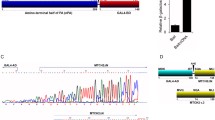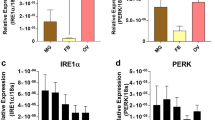Abstract
The flow of calcium ions (Ca2+) is involved in numerous vital activities of Toxoplasma gondii. Calreticulin is a type of Ca2+-binding protein in the endoplasmic reticulum (ER) that is involved in Ca2+ signaling pathway regulation, Ca2+ storage, and protein folding. In this work, the calreticulin (CALR), a protein predicted to possess a conserved domain of calreticulin in T. gondii, was characterized. The CALR localized in the ER. Using reverse genetics, we discovered that CALR is not necessary for the lytic cycle, including invasion and replication. However, depletion of CALR affected microneme secretion triggered by A23187, which is a Ca2+ ionophore used to increase cytoplasmic Ca2+ concentration. Furthermore, we discovered that CALR influences Ca2+ release. Transcriptomic comparison between Δcalr and Δku80 parasites showed that 226 genes in the Δcalr parasites were significantly downregulated (p < 0.05). The cellular biological functions of the downregulated genes were mainly involved in calmodulin-dependent protein kinase pathways. Furthermore, in the absence of CALR, tachyzoites were still able to cause acute infection in mice. These results imply that by influencing ER Ca2+ release content, CALR may further impair the ionophore-induced secretion of the parasite. However, this protein is not required for the completion of the parasite’s lytic cycle or for the acute virulence of the parasite.






Similar content being viewed by others
Data availability
No datasets were generated or analysed during the current study.
References
Arnaudeau S, Frieden M, Nakamura K, Castelbou C, Michalak M, Demaurex N (2002) Calreticulin differentially modulates calcium uptake and release in the endoplasmic reticulum and mitochondria. J Biol Chem 277(48):46696–46705. https://doi.org/10.1074/jbc.M202395200
Baksh S, Michalak M (1991) Expression of calreticulin in Escherichia coli and identification of its Ca2+ binding domains. J Biol Chem 266(32):21458–21465
Bedard K, Szabo E, Michalak M, Opas M (2005) Cellular functions of endoplasmic reticulum chaperones calreticulin, calnexin, and ERp57. Int Rev Cytol 245:91–121. https://doi.org/10.1016/S0074-7696(05)45004-4
Bisio H, Lunghi M, Brochet M, Soldati-Favre D (2019) Phosphatidic acid governs natural egress in Toxoplasma gondii via a guanylate cyclase receptor platform. Nat Microbiol 4(3):420–428. https://doi.org/10.1038/s41564-018-0339-8
Black MW, Arrizabalaga G, Boothroyd JC (2000) Ionophore-resistant mutants of Toxoplasma gondii reveal host cell permeabilization as an early event in egress. Mol Cell Biol 20(24):9399–9408. https://doi.org/10.1128/MCB.20.24.9399-9408
Brown KM, Sibley LD (2018) Essential cGMP signaling in Toxoplasma is initiated by a hybrid P-type ATPase-guanylate cyclase. Cell Host Microbe 24(6):804–816. https://doi.org/10.1016/j.chom.2018.10.015
Brown KM, Lourido S, Sibley LD (2016) Serum albumin stimulates protein kinase G-dependent microneme secretion in Toxoplasma gondii. J Biol Chem 291(18):9554–9565. https://doi.org/10.1074/jbc.M115.700518
Brown KM, Long S, Sibley LD, Weiss LM (2017) Plasma membrane association by N-acylation governs PKG function in Toxoplasma gondii. mBio 8(3):e00375-17. https://doi.org/10.1128/mBio.00375-17
Caldas LA, Souza WD, Attias M (2010) Microscopic analysis of calcium ionophore activated egress of Toxoplasma gondii from the host cell. Vet Parasitol 167(1):8–18. https://doi.org/10.1016/j.vetpar.2009.09.051
Carruthers VB, Sibley LD (1999) Mobilization of intracellular calcium stimulates microneme discharge in Toxoplasma gondii. Mol Microbiol 31(2):421–428. https://doi.org/10.1046/j.1365-2958.1999.01174
Chini EN, Nagamune K, Wetzel DM, Sibley LD (2005) Evidence that the cADPR signalling pathway controls calcium-mediated microneme secretion in Toxoplasma gondii. Biochem J 389:269–277. https://doi.org/10.1042/BJ20041971
Chouquet A, Païdassi H, Ling WL, Frachet P, Houen G, Arlaud GJ, Gaboriaud C (2011) X-ray structure of the human calreticulin globular domain reveals a peptide-binding area and suggests a multi-molecular mechanism. PLoS One 6(3):e17886. https://doi.org/10.1371/journal.pone.0017886
Debrabant A, Lee N, Pogue GP, Dwyer DM, Nakhasi HL (2002) Expression of calreticulin P-domain results in impairment of secretory pathway in Leishmania donovani and reduced parasite survival in macrophages. Int J Parasitol 32(11):1423–1434. https://doi.org/10.1016/s0020-7519(02)00134-0
Dogga SK, Mukherjee B, Jacot D, Kockmann T, Soldati-Favre D (2017) A druggable secretory protein maturase of Toxoplasma essential for invasion and egress. Elife 6:e27480. https://doi.org/10.7554/eLife.27480
Dubois DJ, Soldati-Favre D (2019) Biogenesis and secretion of micronemes in Toxoplasma gondii. Cell Microbiol 21(5):e13018. https://doi.org/10.1111/cmi.13018
Ellgaard L, Riek R, Herrmann T (2001) NMR structure of the calreticulin P-domain. Proc Natl Acad Sci U S A 98(6):3133–3138. https://doi.org/10.1073/pnas.051630098
Fang J, Marchesini N, Moreno SNJ (2006) A Toxoplasma gondii phosphoinositide phospholipase C (TgPI-PLC) with high affinity for phosphatidylinositol. Biochem J 394:417–425. https://doi.org/10.1042/BJ20051393
Giraldo AMV, Medus ML, Lebrero MG, Pagano RS, Labriola CA, Landolfo L, Delfino JM, Parodi AJ, Caramelo JJ (2010) The structure of calreticulin C-terminal domain is modulated by physiological variations of calcium concentration. J Biol Chem 285:4544–4553. https://doi.org/10.1074/jbc.M109.034512
Gutiérrez T, Qi H, Yap MC, Tahbaz N, Milburn LA, Lucchinetti E, Lou PH, Zaugg M, LaPointe PG, Mercier P, Overduin M, Bischof H, Burgstaller S, Malli R, Ballanyi K, Shuai J, Simmen T (2020) The ER chaperone calnexin controls mitochondrial positioning and respiration. Sci Signal 13(638):eaax6660. https://doi.org/10.1126/scisignal.aax6660
Hill DE, Chirukandoth S, Dubey JP (2005) Biology and epidemiology of Toxoplasma gondii in man and animals. Anim Health Res Rev 6(1):41–61. https://doi.org/10.1079/ahr2005100
Jia XY, He LH, Jing RL, Li RZ (2010) Calreticulin: conserved protein and diverse functions in plants. Physiol Plant 136(2):127–138. https://doi.org/10.1111/j.1399-3054.2009.1223.x
Jia Y, Marq JB, Bisio H, Jacot D, Mueller C, Yu L, Choudhary J, Brochet M, Soldatifavre D (2017) Crosstalk between PKA and PKG controls pH-dependent host cell egress of Toxoplasma gondii. EMBO J 36(21):3250–3267. https://doi.org/10.15252/embj.201796794
Kozlov G, Pocanschi CL, Rosenauer A, Bastos-Aristizabal S, Gehring K (2010) Structural basis of carbohydrate recognition by calreticulin. J Biol Chem 285(49):38612–38620. https://doi.org/10.1074/jbc.M110.168294
Kusum Y, Anurag Y, Priyanka VP, Pandey VP, Dwivedi UN (2019) Protein misfolding diseases and therapeutic approaches. Curr Protein Pept Sci 20(12):1226–1245. https://doi.org/10.2174/1389203720666190610092840
Labriola CA, Conte IL, Máximo LM, Parodi AJ, Caramelo JJ, Martins BE (2010) Endoplasmic reticulum calcium regulates the retrotranslocation of Trypanosoma cruzi calreticulin to the cytosol. PLoS ONE 5(10):e13141. https://doi.org/10.1371/journal.pone.0013141
Lan B, He Y, Sun H, Zheng X, Gao Y, Li N (2019) The roles of mitochondria-associated membranes in mitochondrial quality control under endoplasmic reticulum stress. Life Sci 231:116587. https://doi.org/10.1016/j.lfs.2019.116587
Lourido S, Shuman J, Zhang C, Shokat KM, Hui R, Sibley LD (2010) Calcium-dependent protein kinase 1 is an essential regulator of exocytosis in Toxoplasma. Nature 465(7296):359–362. https://doi.org/10.1038/nature09022
Marchi S, Patergnani S, Missiroli S, Morciano G, Pinton P (2018) Mitochondrial and endoplasmic reticulum calcium homeostasis and cell death. Cell Calcium 69:62–72. https://doi.org/10.1016/j.ceca.2017.05.003
Mccoy JM, Whitehead L, Van Dooren GG, Tonkin CJ, Soldati-Favre D (2012) TgCDPK3 regulates calcium-dependent egress of Toxoplasma gondii from host cells. PLoS Pathog 8(12):e1003066. https://doi.org/10.1371/journal.ppat.1003066
Michalak M, Corbett EF, Mesaeli N, Nakamura K, Opas M (1999) Calreticulin: one protein, one gene, many functions. Biochem J 344 Pt(Pt 2):281–292
Michalak M, Groenendyk J, Szabo E, Gold LI, Opas M (2009) Calreticulin, a multi-process calcium-buffering chaperone of the endoplasmic reticulum. Biochem J 417(3):651–666. https://doi.org/10.1042/BJ20081847
Millholland MG, Mishra S, Dupont CD, Love MS, Patel B, Shilling D, Kazanietz MG, Foskett JK, Hunter CA, Sinnis P, Greenbaum DC (2013) A host GPCR signaling network required for the cytolysis of infected cells facilitates release of apicomplexan parasites. Cell Host Microbe 13(1):15–28. https://doi.org/10.1016/j.chom.2012.12.001
Oliver JD, Roderick HL, Llewellyn DH, High S (1999) ERp57 functions as a subunit of specific complexes formed with the ER lectins calreticulin and calnexin. Mol Biol Cell 10(8):2573–2582. https://doi.org/10.1091/mbc.10.8.2573
Patra S, Mahapatra KK, Praharaj PP, Panigrahi DP, Bhol CS, Mishra SR, Behera BP, Singh A, Jena M, Bhutia SK (2021) Intricate role of mitochondrial calcium signalling in mitochondrial quality control for regulation of cancer cell fate. Mitochondrion 57:230–240. https://doi.org/10.1016/j.mito.2021.01.002
Paul AS, Saha S, Engelberg K, Jiang RHY, Coleman BI, Kosber AL, Chen CT, Ganter M, Espy N, Gilberger TW (2015) Parasite calcineurin regulates host cell recognition and attachment by apicomplexans. Cell Host Microbe 18(1):49–60. https://doi.org/10.1016/j.chom.2015.06.003
Peterson JR, Ora A, Van PN, Helenius A (1995) Transient, lectin-like association of calreticulin with folding intermediates of cellular and viral glycoproteins. Mol Biol Cell 6(9):1173–1184. https://doi.org/10.1091/mbc.6.9.1173
Roiko MS, Svezhova N, Carruthers VB, Knoll LJ (2014) Acidification activates Toxoplasma gondii motility and egress by enhancing protein secretion and cytolytic activity. PLoS Pathog 10(11):e1004488. https://doi.org/10.1371/journal.ppat.1004488
Schurch P, Malinovska L, Wildschut T, Lakkaraju A, Lysenko V, Aguzzi A, Picotti P, Theocharides APA (2020) Homozygous calreticulin mutations affect chaperone function and perturb the glycoproteome. Cell Rep 41(8):111689. https://doi.org/10.1016/j.celrep.2022.111689
Soldati D, Dubremetz JF, Lebrun M (2001) Microneme proteins: structural and functional requirements to promote adhesion and invasion by the apicomplexan parasite Toxoplasma gondii. Int J Parasitol 31(12):1293–1302. https://doi.org/10.1016/s0020-7519(01)00257-0
Song HO, Ahn MH, Ryu JS, Min DY, Lee YH (2005) Influence of calcium ion on host cell invasion and intracellular replication by Toxoplasma gondii. Korean J Parasitol 42(4):185–193. https://doi.org/10.3347/kjp.2004.42.4.185
Treeck M, Sanders JL, Gaji RY, Lafavers KA, Boothroyd JC (2014) The calcium-dependent protein kinase 3 of Toxoplasma influences basal calcium levels and functions beyond egress as revealed by quantitative phosphoproteome analysis. PLoS Pathog 10(6):e1004197. https://doi.org/10.1371/journal.ppat.1004197
Acknowledgements
We appreciate Prof. Shaojun Long’s advice and assistance (China Agricultural University). We are also grateful to Prof. Bang Shen (Huazhong Agricultural University) for providing CRISPR/Cas9 plasmid.
Funding
This work was supported by the National Key Research and Development Program of China (2022YFD1800200, 2023YFD1802400).
Author information
Authors and Affiliations
Contributions
Qun Liu and Zhili Shan conceived and designed this study and wrote the manuscript. Zhili Shan, Xingju Song and Xu Yang analysed the data and generated the figures. Zhili Shan, Xingju Song, Xianmei Wang, Yayun Wu, Yangfei Xue and Jing Liu performed the experiments.
Corresponding author
Ethics declarations
Ethics approval
Animal experiments were conducted in strict compliances with the Guidelines for the Care and Use of Laboratory Animals of the Ministry of Science and Technology of China. All experimental protocols were approved by the Institutional Animal Care and Use Committee of China Agricultural University (under the certificate of Beijing Laboratory Animal staff ID: 18049).
Consent for publication
All authors gave their consent before submitting this work.
Competing interests
The authors declare no competing interests.
Additional information
Section Editor: Xing-Quan Zhu
Publisher's Note
Springer Nature remains neutral with regard to jurisdictional claims in published maps and institutional affiliations.
Supplementary Information
Below is the link to the electronic supplementary material.
Supplementary file2 (AVI 153006 KB)
Supplementary file3 (AVI 612006 KB)
Supplementary file4 (AVI 612006 KB)
Supplementary file5 (AVI 612006 KB)
Supplementary file6 (AVI 612006 KB)
Supplementary file7 (AVI 612006 KB)
Rights and permissions
Springer Nature or its licensor (e.g. a society or other partner) holds exclusive rights to this article under a publishing agreement with the author(s) or other rightsholder(s); author self-archiving of the accepted manuscript version of this article is solely governed by the terms of such publishing agreement and applicable law.
About this article
Cite this article
Shan, Z., Song, X., Yang, X. et al. Calreticulin (CALR) promotes ionophore-induced microneme secretion in Toxoplasma gondii. Parasitol Res 123, 139 (2024). https://doi.org/10.1007/s00436-024-08162-9
Received:
Accepted:
Published:
DOI: https://doi.org/10.1007/s00436-024-08162-9




